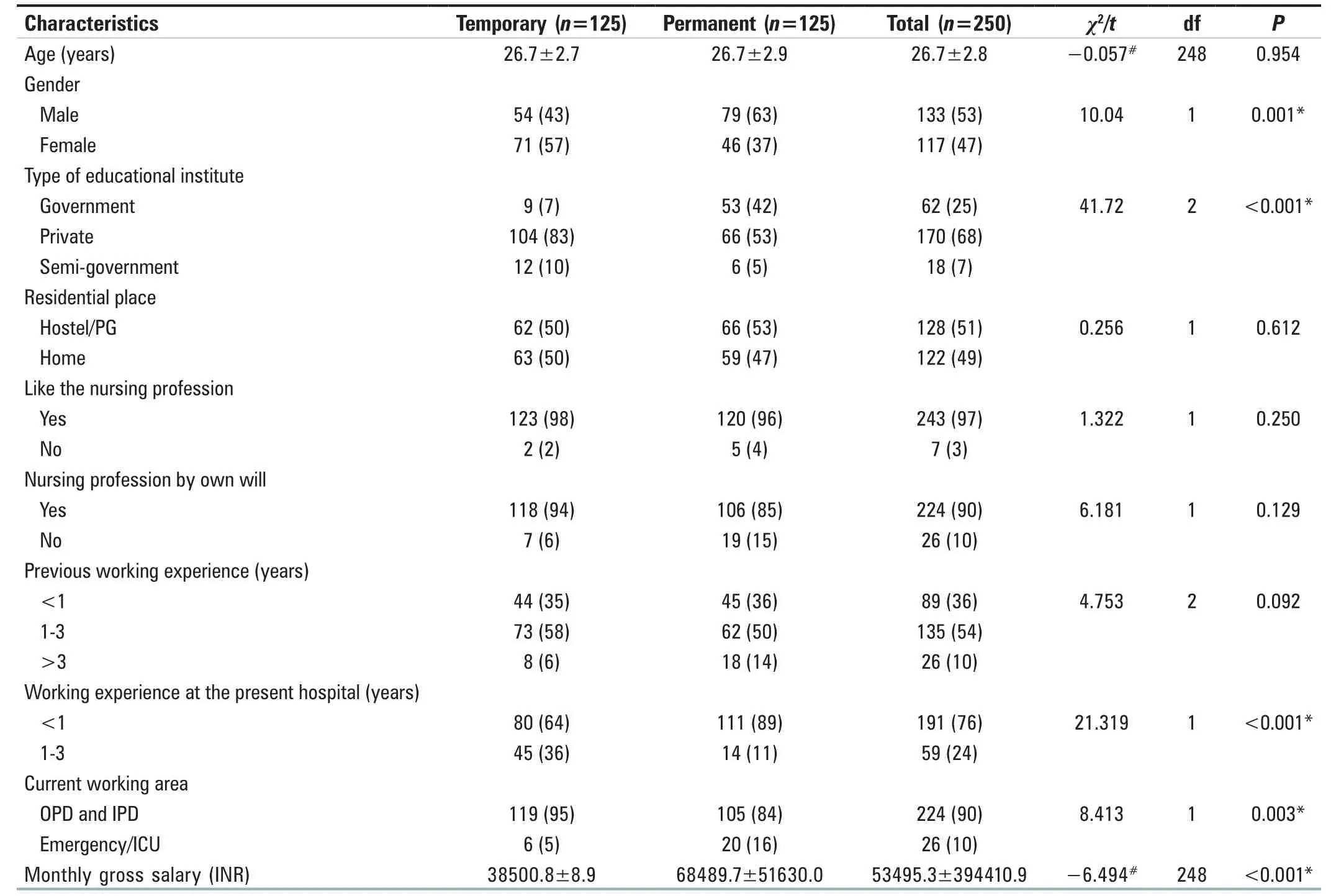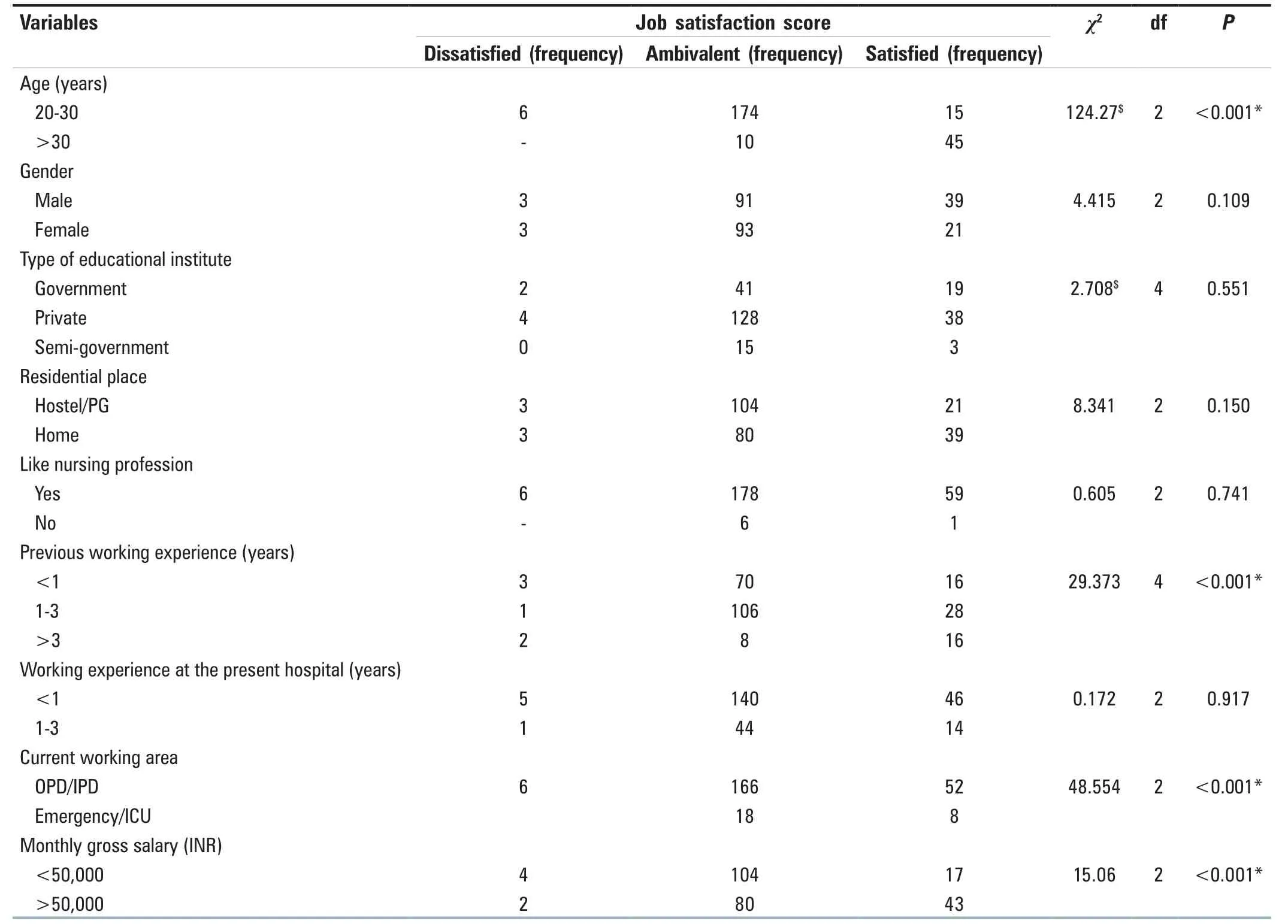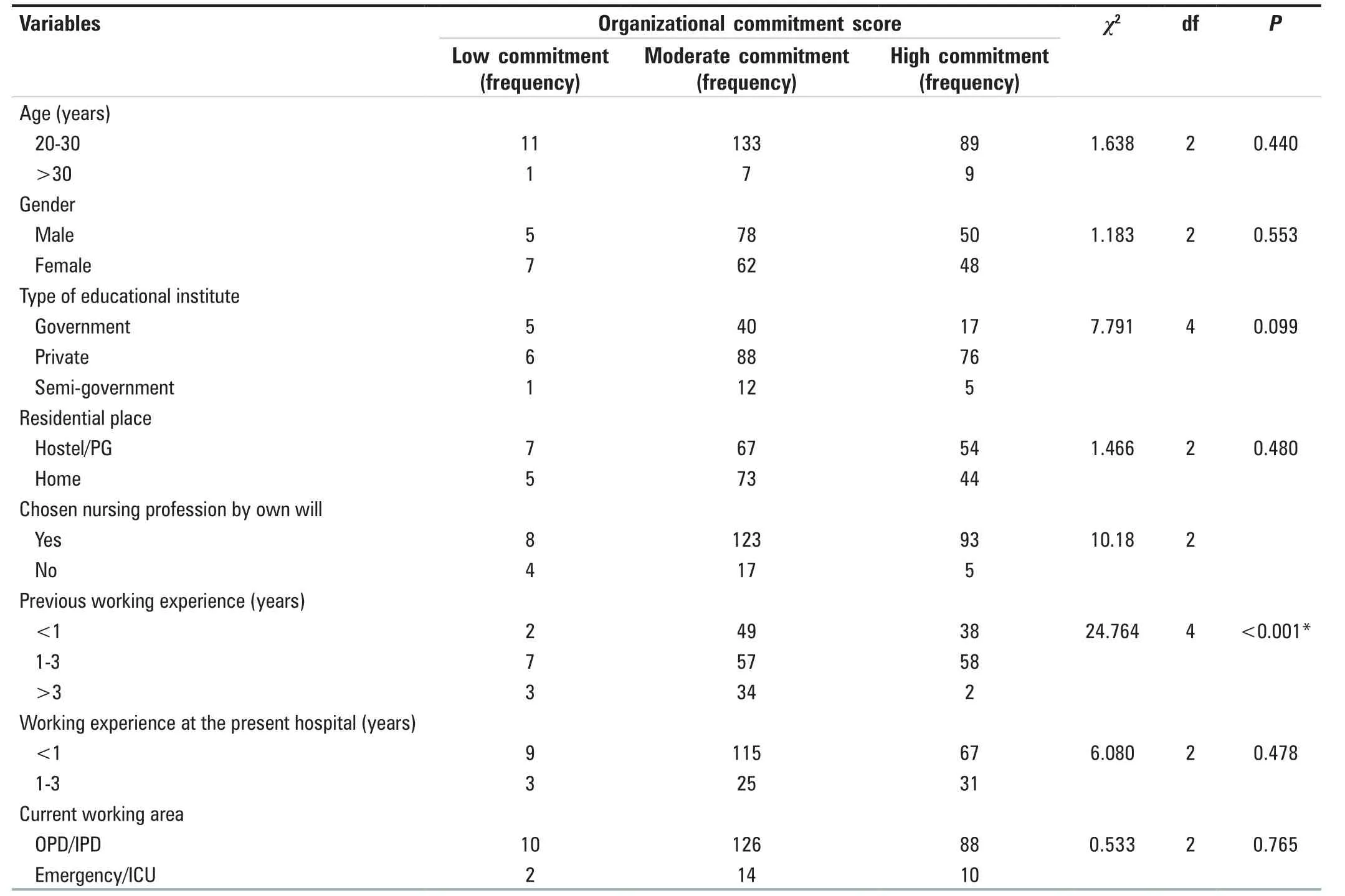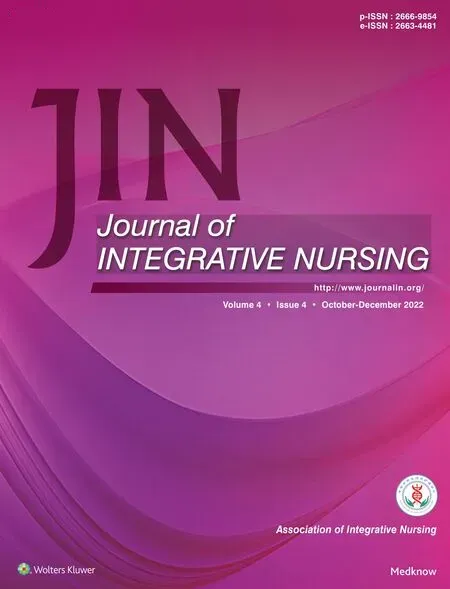Job satisfaction and organizational commitment among nurses working on temporary versus permanent jobs at a tertiary care teaching hospital,Uttarakhand,lndia
Neha PANCHAL,Suresh Kumar SHARMA,Rakesh SHARMA,Ritu RANI
1Department of Neurosurgery,Vardhman Mahavir Medical College and Safdarjung Hospital,New Dehli,India;2College of Nursing,All India Institute of Medical Sciences,Jodhpur,Rajasthan,India;3College of Nursing,All India Institute of Medical Sciences,Rishikesh,Uttarakhand,India
ABSTRACT Objective:The objective of this study was to assess and compare job satisfaction and organizational commitment among nurses working on temporary versus permanent basis at a tertiary care teaching hospital,Uttarakhand,India.Materials and Methods:A total of 250 nurses (125 temporary and 125 permanent) were selected using stratified disproportionate random sampling techniques from a tertiary care teaching hospital.Sociodemographic datasheet,Job Satisfaction Survey scale,and Organizational Commitment scale were used to collect data.Results:The study results revealed that the job satisfaction score was significantly higher in permanent nurses (139.1 ± 15.4) than in temporary nurses (131.3 ± 12.2) (P < 0.001).However,temporary nurses (85.2 ± 14.4) were more committed toward organization than permanent nurses (80.0 ± 16.0) (P < 0.001).There was a significant association between nurses’ job satisfaction and their gross salary (P < 0.001) and their organizational commitment with the selected profession by own will (P < 0.001).Conclusion:The present study concluded that majority of temporary and permanent nurses reported a moderate level of job satisfaction and organizational commitment.This study suggests enhancing employee satisfaction can improve organizational commitment.As well,this study’s findings can serve as a valuable foundation for designing policies to enhance organizational commitment in the future.
Keywords: Health-care services,job satisfaction,organizational commitment,permanent nurses,temporary nurses
INTRODUCTION
Currently,health organizations are facing serious challenges due to an aging population and public expectations that are progressively increasing.[1]Nurses play a vital role among all the health-care professionals in the health-care industry.[2]Many times,they are the first and only health-care provider patients encounter.[3]Nurses spend a longer amount of time caring for patients than physicians.However,nurses have also been reported to be the most stressed among health-care professionals,who can adversely affect patient care.[2]In order to perform well at work,employees must be satisfied at the job.[4]
Job satisfaction is a unique aspect that can create differences between actual performances and anticipated outcomes.[5]Job satisfaction refers to people’s feelings regarding their work and various aspects of their jobs.This relates to how satisfied (satisfaction) or dissatisfied (dissatisfaction) people are with their jobs.[6]Satisfied health-care professionals improve the quality of patient-care services and the intention to remain within the health-care industry.On the other hand,job dissatisfaction has a negative effect on health-care organizations,such as increased absenteeism,high stress,increased work-related errors/accidents,increased intention to leave,increased turnover,and reduced commitment to work and organization.[7-9]An organization’s employees’commitment can be classified according to its desire (affective commitment),obligation (normative commitment),and cost (continuance commitment).[10]According to a study,48.3% of nurses wanted to leave the profession,and 53.3%wanted to leave the organization as soon as possible.They clarified it by saying that many of the nurses do not want to pursue nursing as a career and instead want to apply to universities to pursue their primary educational goals.Nursing education policies were an obstacle,so they began exploring another area to pursue a higher educational degree.[11]
The WHO reports that by the year 2035,the health workforce shortage will reach 12.9 million,with 47% and 25% of the shortage occurring in South-East Asia and Africa,respectively.[12]In order to overcome this challenge,health professionals should improve their job satisfaction levels to increase their intention to stay.[12]Furthermore,job satisfaction among employees leads to increase commitment toward organization.[5]As a result,their work satisfaction must be determined to measure their commitment to the organization.Therefore,assessing these critical aspects of work attitudes between two professional groups of nurses,i.e.,temporary and permanent nurses,is essential.These results will help nursing managers to develop strategies to increase organizational commitment and job satisfaction among temporary and permanent nurses,resulting in improved organizational performance and patients’health-care outcomes.Therefore,this study was designed to assess and compare job satisfaction and organizational commitment among nurses employed both on a temporary and permanent basis in a tertiary care teaching hospital in Uttarakhand,India.
MATERIALS AND METHODS
A descriptive comparative study was conducted among temporary and permanent nurses working at a tertiary care teaching hospital in Uttarakhand,a state located in the Northern part of India.The study was conducted from October 2018 to February 2019.The Stratified Disproportionate Random Sampling technique was used to enroll nurses who met the inclusion criteria.Inclusion criteria were temporary and permanent nurses with at least 6 months of working experience in their present working hospital and who were willing to participate in the study.Permanent nurses refer to the registered nurses working in the selected hospital,appointed for regular post and do not have a predetermined end date to employment and are regularly paid by organization.Temporary nurses were the registered nurses employed through workforce agencies to hospitals and have only 11 months of employment with consolidated salary,to deal shortage of nurses.A sample size of 250 (125 temporary and 125 permanent nurses)was estimated using the prevalence sample size calculation formula (n=([1-n/N]×t∧2 [p×q]/d∧2).Prevalence was taken from the previous study[13]with a 95% confidence interval and 80% power.
Ethical considerations
The ethical approval was obtained from the Institutional Ethical Committee of AIIMS,Rishikesh,with Reference Number 68/IEC/PGN/2018,dated June 5,2018.After providing a participant information sheet to participants,the informed consent was obtained.The participants were informed about the research’s purpose and ensured anonymity and confidentiality of the information.
Research instruments and data collection
Data collection was done by providing the self-administered tools to the study participants,which are as follows.
Sociodemographic profile sheet
It was a self-structured tool prepared in the English language to collect baseline information of the participants,containing 12 items such as age,gender,and educational status.
Job Satisfaction Survey
It was a structured instrument created by Spector[14]to evaluate employee attitudes toward the job and its different aspects.It is a 36-item,9-facet scale,with four items for each facet,and a total score calculated from all items.The researchers used a summated rating scale format with six options per item ranging from “strongly disagree” to“strongly agree.” The Job Satisfaction Survey (JSS) scale for work satisfaction was scored according to the instructions;the total score ranged from 36 to 216,which was divided into three categories: 36-108 (dissatisfied),108-144 (ambivalent),and 144-216 (satisfied).
Organizational Commitment scale
It was a standardized scale developed by Meyer and Alien.[15]It was an 18-item scale with three subscales to assess nurses’commitment to the organization.The three-component model assesses three types of employee commitment to the organization: affective (emotional),continuance (cost-based),and normative commitment (obligation-based).On a 7-point Likert scale,responses ranged from “1 (strongly disagree)”to “7 (strongly agree).” It implies that the higher the score,the greater the level of commitment.
Validity and reliability of tools
The validity of the tools was established by five nursing experts.The reliability of standardized tools had already been established.The internal consistency of Spector’s JSS and Meyer and Alien’s Organizational Commitment scale is 0.91 and 0.77,respectively.
The participants were given self-administered demographic profile,job satisfaction,and organizational commitment questionnaires to complete.The duration of data collection for each participant was approximately 20 min.The data collection process was terminated after thanking each respondent for their participation and cooperation.
Statistical analysis
The Statistical Package for the Social Sciences (SPSS)version 23.0 (IBM Corp.Released 2015.IBM SPSS Statistics for Windows,Version 23.0.Armonk,NY,USA: IBM Corp) was used to analyze the results.Data analysis was performed using descriptive and inferential statistics.The demographic variables were presented in frequency,percentage,mean,and standard deviation.Categorical variables were compared using Chi-square test,and independentt-test was used to compare continuous variables such as age and gross salary.Furthermore,independentt-test was used to compare the scores of job satisfaction and organizational commitment between temporary and permanent nurses.Whereas association of job satisfaction and organizational commitment with selected demographic variables was measured using the Chi-square test and Fisher’s exact test as applicable.The significance level for each test was considered atP=0.05 for 95% confidence level.
RESULTS
The total number of nurses who participated in the study was 250.The mean age of temporary and permanent nurses was 26.7 ± 2.7 years and 26.7 ± 2.9 years,respectively.Both groups of nurses did not show any significant difference in their demographic profile except gender,type of educational institute,working experience at the present hospital(in years),current working areas,and salary per month,as illustrated in Table 1.
It was observed that maximum nurses had ambivalent satisfaction levels in both the groups (83% in temporary nurses and 64% in permanent nurses).In terms of organizational commitment,more than half of the nurses had a moderate level of commitment in both the groups (51% in temporary nurses and 62% in permanent nurses).There was a significantly higher job satisfaction among permanent nurses compared to temporary nurses (P< 0.01).However,nurses working on a temporary basis had significantly higher organizational commitment than nurses who had permanent jobs (P< 0.001),[Table 2].
A significant association was identified between level of job satisfaction with the gross salary (P< 0.001) of nurses working on temporary and permanent basis,as illustrated in Table 3.A significant association was found between the level of organizational commitment with selected profession by own will (P< 0.001),as shown in Table 4.
DISCUSSION
In the present study,most temporary and permanent nurses were neither satisfied nor dissatisfied with their jobs.Whereas according to a study conducted in Pune,47% of nurses were dissatisfied with their jobs,while 45%were neutral.[16]However,the proportions are about equal.In contrast,a study in Nepal states that nurses are highly satisfied with their jobs as they get a chance to help people,followed by nurses satisfied with religious belief as a factor.[17]While comparing the job satisfaction of staff nurses,those working in a corporate hospital are more satisfied than those in a government or a mission hospital.There are no obvious reasons for this.However,it is evident that proactive measures can increase staff nurse satisfaction in all settings.[18]In addition to the findings of recent Western studies,nurses in the US,Australia,and Canada reported higher job satisfaction than those in a study conducted in Hong Kong,China.The findings revealed that the nurses in the Western countries have more job satisfaction,which may be due to smaller nurse-patient ratios and a better standard of professional development and autonomy in overseas countries such as the U.S.and England.[19]
However,in the current study,the overall satisfaction was higher in permanent nurses compared to temporary nurses.This could be due to nurses working on a temporary basis had fewer days off,lower gross pay,and job insecurity than permanent nurses,resulting in higher dissatisfaction.In a similar vein,a study conducted by Dixitet al.[13]found that regular staff was more satisfied with their employment than contractual staff.The degree of job satisfaction and the gross income of nurses were shown to have a strong relationship in our study.In the same line,in a study conducted in aprivate hospital,the salary was identified as the second most satisfactory component.[19]Besides,differences in wages and allowances,poor organizational facilities,pension benefits,residential accommodations,transportation facilities,lack of promotion,and potential career prospects were all reported by Dixitet al.[13]as reasons for lower satisfaction among contractual health-care staff.Our study found that nurses working on a temporary basis had significantly higher organizational commitment than nurses who had permanent jobs.It is likely because temporary nurses are afraid of losing their jobs.However,a study conducted by Mohamed and Abed[20]found no significant variations in commitment levels between permanent and temporary nurses in general.

Table 1: Sociodemographic profile of the study participants (n=250)

Table 2: Level of job satisfaction and organizational commitment (n=250)
Furthermore,the findings of the present study revealed that there was a significant relationship between job satisfaction and organizational commitment among nurses employed on a temporary and permanent basis.The results of the study by Al-Hussein[21]also pressed the importance of job satisfaction as a significant predictor of organizational commitment.Consequently,satisfied nurses tend to show high levels of loyalty to their hospitals,whereas dissatisfied ones tend to show low levels of loyalty.

Table 3: Level of association of job satisfaction with selected demographic variables (n=250)
According to the results of this study,no significant relationship was identified between organizational commitment and age,gender,religion,educational status,working department,professional education,and years of experience.In contrast,Labragueet al.[22]stated that nurse’s age,experience,and education had a direct relationship with organizational engagement.We found a positive association between levels of organizational commitment and profession selection by own will.This point emphasizes the importance of choosing a career based on one’s own preferences to develop a positive attitude toward work and increase organizational engagement.
This study contributes to the domain of research on nurses’job satisfaction and organizational commitment but has some limitations.This study was limited to nurses from a single tertiary care hospital,with a restricted sample size,and nurses with at least 6 months of experience only,which reduces the generalizability.Furthermore,qualitative research could be done to explore more regarding nurses’ job satisfaction and commitment to the organization and the factors influencing it.
CONCLUSION
The present study concluded higher job satisfaction among permanent nurses,whereas higher organizational commitment was found among temporary nurses.Furthermore,there was a significant relationship between organizational commitment among nurses working on temporary and permanent job.As a result,different interventions are expected to develop and maintain job satisfaction,which can contribute to increased organizational commitment and improved patient health outcomes.
Acknowledgment
We would like to thank all the nurses for participating in this study.

Table 4: Level of association of organizational commitment with selected demographic variables (n=250)
Financial support and sponsorship
Nil.
Conflicts of interest
There are no conflicts of interest.
 Journal of Integrative Nursing2022年4期
Journal of Integrative Nursing2022年4期
- Journal of Integrative Nursing的其它文章
- A simple concept of fluid balance can be harder in the intensive care unit
- Operation rules of scraping technique
- A nurse-led occupational health promotion program for farmers
- Diabetes knowledge and self-care practices among people living with type 2 diabetes mellitus in a diabetes clinic in Southwestern Nigeria
- Nursing students’ experiences of horizontal violence and occupational belonging during clinical placements
- Quality of life and psychological impact among chronic disease patients during the COVlD-19 pandemic
